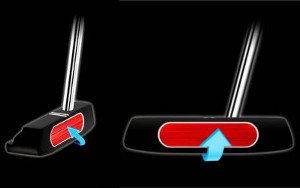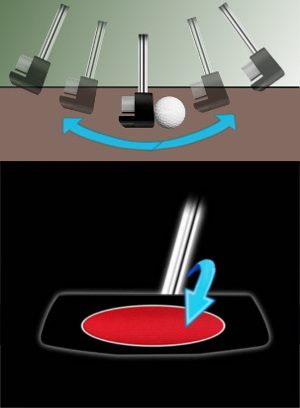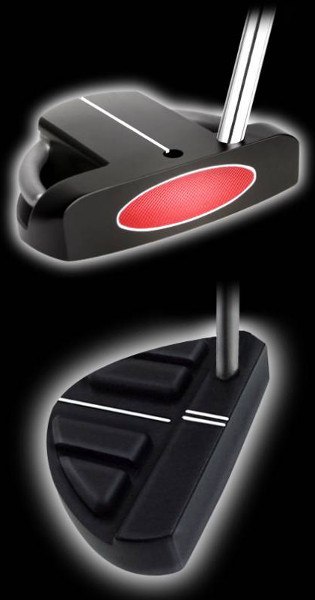The putter is one of the most important clubs in your bag.

You may spend more time thinking about the specs of your driver or your set of irons, but having the right putter is critical to your success on the course. More than any other club you purchase, the putter you select is going to come down to personal preference more than anything else. Modern club fitting techniques can help tremendously when selecting a driver, for instance, but they have limited utility when it comes to the flat stick. For this selection, you’ll want to test out a variety of models and go with the one that seems to lead to the best results.
In this article, we are going to talk about one type of putter you may see in your local pro shop – a putter with a face insert. Basically, a face insert is an insert made of a different material than the rest of the putter head. The insert will be positioned to cover the sweet spot on the face, plus a little bit of room for error on each side. The use of face inserts is relatively common when it comes to putter, yet many golfers don’t know what they are for or how they can help. Hopefully, this article will clear up any confusion you may have on the topic. Additionally, we will touch on some other key putter elements to keep in mind as you shop.
Before we get into the specifics of this discussion, it is worth pointing out that you don’t necessarily need to spend top dollar on your putter in order to make more putts. Some golfers do find success by paying hundreds of dollars for their putter – while others putt just as well with a club they bought out of the used bin for less than $20. Don’t be a golfer who is sucked into the idea of paying more and more for clubs, thinking that your investment will be directly reflected in your performance. It may not be. The goal is simply to find the best clubs for your personal style and technique, regardless of how much those clubs may happen to cost. It is a good idea to set out a budget in advance for any golf purchases and then shop among the clubs that will allow you to remain within that budgetary constraint.
All of the content below is based on a right-handed golfer. If you happen to play left-handed, please take a moment to reverse the directions as necessary.
The Idea of an Insert

So, why would a club company bother putting an insert into the face of a putter? It would obviously be easier to leave the insert out and just make the putter head out of one piece of the same material, so there must be some performance benefit in mind here. In fact, there are two. The two points listed below are generally considered to be the two possible benefit of using a face insert in a putter.
- Soften the feel. If the designer of the club wants to soften the way the ball feels when it leaves the putter face at impact, using a face insert may be the option they select to achieve that goal. By using a different, softer material, the designer can create a soft feel without changing the rest of the head. This is often a feature that is desired by golfers who use distance golf balls. Those types of balls generally have hard covers, meaning the feel off the putter face may not be great. So, by using an insert, the putter designer can offer the player better feel without the need to change golf ball. Of course, the use of putters with a face insert is not necessarily limited to players who use distance balls, as players of all skill levels have been known to use these kinds of putters.
- Change the weighting. Generally speaking, the material that makes up the face insert is going to weigh less than the material which was replaced. As a result, the weighting of the putter is going to be altered, at least to some degree. The weight will be moved out of the center of the face, meaning the outer areas of the putter will be relatively heavier as a result. And, fortunately, this can mean good things for the golf. By moving weight away from the center of the putter, the MOI will increase, and the putter will feel more stable through the hitting area. When you hit a putt slightly off the toe or the heel, the putter should be less-prone to twist. Obviously, a putter which resists twisting is desirable because it should help the player hit the target line more frequently.
Everything sounds pretty good up to this point. You get to soften the feel of the ball at impact, and you alter the weighting in what should be a good way. So, why don’t all putters have face inserts? Well, the simple fact is that some golfers just don’t like the way these kinds of putters feel. When the impact is made a bit softer, some of the feel that is usually transferred from the ball up to the hands is lost. The player may not feel like he or she can control the distance of their putts as well as with a putter made from a single material. Since putting well is all about feel and distance control, this is certainly a big deal.
For some golfers, the addition of an insert makes the face of the putter feel like a trampoline. The club swings into the ball at impact, the ball rebounds off the face, and it shoots off toward the hole. The feeling of control over the ball is lost for some golfers, and their touch struggles to come back until they revert to a traditional putter. That is certainly not to say that all golfers will feel this way, but don’t assume that you will love the feel of an insert putter just because it is softer.
Are You a Good Candidate?

Now that you have a basic idea of what a putter face insert is, and why one would be used, it’s time to turn the focus to your game. Are you a good candidate for this kind of putter? Are you likely to benefit from buying a putter with a face insert, or should you stick with a traditional model where the head is made from just one material? Let’s take a look at those questions in this section.
First, it needs to be said that it is never a good idea to attempt something which isn’t broken. If you are already putting great with your current insert-free model, why make a change? It’s very much possible to have your performance go in the wrong direction if you make this change, so don’t risk it if your putting performance is already satisfactory. Many golfers have made themselves worse by purchasing equipment that they hoped would make them even better. The goal when buying any new golf club is to make the game a little easier on yourself. Should you happen to already be a good putter, forget about replacing your flat stick and focus your attention on other parts of the bag.
On the other hand, if your putting is currently holding you back and you would like to make a change of some kind, the points below may indicate that you are a good candidate for a putter which features a face insert.
- You use a firm golf ball. If you usually use a golf ball which features a firm cover, picking a putter with an insert may be a good choice. We mentioned this point earlier, but it bears repeating here. The softer feel of the face insert should help to offset the firm cover on your ball, leaving you with a pleasant feeling impact when you strike your putts. How do you know if your ball has a firm cover? The cost of the golf ball is a pretty good indication. If you paid less than $20 or $25 for a dozen of your current golf ball model, the cover is likely pretty firm. The balls which feel softer in the short game tend to sell for at least $30 per dozen, if not more. You certainly don’t have to use a face insert when you opt for a distance ball, but it is an option to keep in mind.
- You have a handsy putting stroke. Ideally, you would swing the putter back and through by using almost entirely a rocking motion with your shoulders and almost no input from your hands and wrists. However, some golfers have trouble attaining that goal, and they wind up using a little more hand and wrist action in the stroke than would be desired. If that sounds like you, a putter face insert may help you control the speed of your putts a little more effectively. The ball is going to come off the face quickly with this type of stroke, and you may run a lot of your putts past the cup as a result. With an insert to create softer impact conditions, some of that excess speed could be taken away and you might be able to improve your distance control. Of course, it would still be best to work toward a pendulum-style stroke but opting for a putter with a face insert could be a good way to go for the time being.
- You play regularly on fast greens. If your home course, or most of the courses in your area, usually feature fast greens, a putter with an insert may help you deal with the challenges of such putting surfaces. Again, it comes down to the soft feel of the insert and the way the ball will come off the putter with just a bit less speed. If you count yourself among the many who struggle with controlling the speed of their putts when the greens speed up, a face insert may be an excellent way to deal with that issue.
In the end, it will be up to you to figure out whether or not a putter with a face insert is going to serve you well. Fortunately, it’s not hard at all to test one of these kinds of putters out for yourself. Most pro shops will have a great selection of putters to pick from, including many with face inserts. Ask if you can try a few out and see what you think. Of course, not all face inserts are created equal, so it’s likely that you’ll find you like some better than others. With any luck, you’ll manage to find one that suits your stroke perfectly and will wind up serving you well for many rounds to come.
Other Putter Features to Watch

It should go without saying that the face is an extremely important part of the equation when picking out a putter. After all, this is the only part of the putter that is going to actually come into contact with the ball as you play (hopefully). However, there are plenty of other elements to consider when trying to pick out a putter that will work nicely for you. Let’s walk through some of the other variables to keep in mind.
- Length of the putter. This might seem like a simple point, but it is an important one to think about as you shop. You want the putter to be a comfortable length, so you can take a natural stance and let your hands hang down right to the top of the grip. Some golfers think it’s okay to buy a putter which is too long and simply choke down in order to allow their hands to fall in a comfortable spot. That really isn’t a good idea. You might be able to establish a comfortable length for the putter that way, but you are going to throw off the intended weighting. The putter will feel heavier when you have your hands all the way at the top of the club, which is going to be a good thing in most cases. Feeling the full weight of the club should help you produce a nice tempo, and that tempo will help you control your distance properly.
- Grip. The grip on the putter is an important part of the equipment puzzle. Of course, this does not have to be a big consideration when purchasing a putter, as you can always have the grip replaced if you don’t like the one that comes installed by the manufacturer. There are a couple of things to think about as you look for a grip that will help you putt at your highest possible level. First, of course, is natural comfortable. Does the material of the grip feel good in your hands? This is a personal preference issue, so it’s not a matter of one option being better than another. Also, you will want to think about the thickness of the grip. Some putter grips are thicker than others, and the thickness you select will have a direct impact on the type of stroke you are able to create. For most players, a thicker grip is going to lead to a stroke which has less hand and wrist action. If you struggle to keep your hands quiet while putting, consider trying a thicker grip as a way to rectify that issue. On the other hand, if you are already good at making a pendulum stroke using your shoulders to move the club, staying with a thin grip can give you a better feel for the ball at impact. As is always the case with golf equipment, testing is going to be your friend here. Test out some grip options before settling on one to install on your putter.
- Style of the putter head. This is a big one. Do you want to use a blade-style putter head, or a mallet-style? It is certainly possible to putt well with either option. With a mallet, you will have more mass to work with, and you should be able to make a smooth, flowing stroke without much trouble. On the other hand, a blade may feel like you have more control over the way the putter swings, and you may get more feedback at impact. This is one of those golf debates which seems to rage on and on, with no end in sight. Some golfers swear by blade putters, and others love mallets. There is no right or wrong, of course, but you will need to decide which is the best fit for you.
It would be a mistake to simply walk into a pro shop, try a couple putters, and buy one without further thought. There is a lot that goes into picking out the right putter, and you should give yourself some time to make a smart choice.
Final Thoughts

As we wind down our article on putter face inserts, we’d like to touch on a few final points.
- You can have both. If you are a serious golfer, you might find that you want to own more than one putter. And if that is the case, consider owning one with an insert and one without. You may find that one works better than the other during specific parts of the season. For instance, during the colder months when the greens are probably a bit slower, the non-insert model could be the winner. Then, as the temperatures warm up and the greens speed up, turning to the insert may pay dividends. You don’t want to be switching back and forth constantly but having an alternative waiting in the garage does make some sense.
- Tune out the marketing. To some degree, the marketing machine that is used by many equipment companies to sell clubs needs to be ignored. It’s not that they are necessarily wrong about the features and benefits available with a specific club, but you might be getting just as much performance from your current model. Yet again, we come back to the concept of testing out clubs for yourself. It’s all well and good for someone to tell you that a specific club will offer you certain benefits – it’s something else entirely for that actually to play out in real life.
- Spend some time. If you do decide to switch from a traditional putter to one with a face insert, be sure to spend plenty of practice time getting familiar with your new flat stick. The number one job you’ll need to monitor during those practice sessions is learning how to manage the distance of your putts properly. The ball is going to feel different coming off the putter face, and that new feel is going to directly impact how far the ball rolls. Hit plenty of long putts back and forth across the practice green, along with going through your usual routine for short putts. Gradually, your feel for this new putter will get better and better, and you’ll start to see improved results on the course.
We hope this article has helped you gain a better understanding of the topic of putter face inserts. While there are many great putters on the market that don’t feature inserts, plenty of the top models do include this feature. It will be up to you to decide whether or not a putter with an insert is going to be the right option to take your game to a new level. Whatever you choose, never overlook the importance of the other aspects of the putter while going through the buying process. Also, you can never overlook the importance of proper practice time to acclimate yourself to a new golf club – especially a putter. Good luck!





